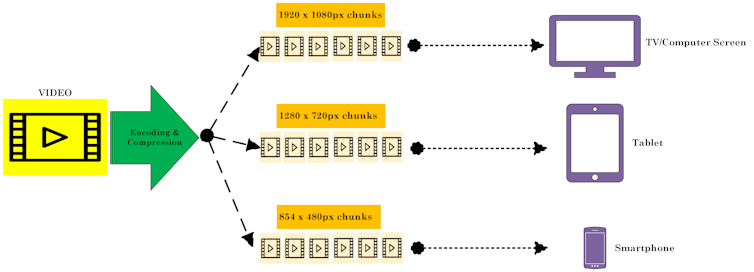Live and on-demand video constituted an estimated 66% of global internet traffic by volume in 2022, and the top 10 days for internet traffic in 2024 coincided with live streaming events such as the Jake Paul vs. Mike Tyson boxing match and coverage of the NFL. Streaming enables seamless, on-demand access to video content, from online gaming to short videos like TikToks, and longer content such as movies, podcasts and NFL games.
The defining aspect of streaming is its on-demand nature. Consider the global reach of a Joe Rogan podcast episode or the live coverage of the SpaceX Crew Dragon spacecraft launch – both examples demonstrate how streaming connects millions of viewers to real-time and on-demand content worldwide.
I’m a computer scientist whose research includes cloud computing, which is the distribution of computing resources such as video servers across the internet.
Netflix claimed that it supported 65 million concurrent streams for the Jake Paul vs. Mike Tyson boxing match on Nov. 15, 2024, though many users reported technical issues.
‘Chunks’ of video
When it comes to video content – whether it’s a live stream or a prerecorded video – there are two major challenges to address. First, video data is massive in size, making it time-consuming to transmit from the source to devices such as TVs, computers, tablets and smartphones.
Second, streaming must be adaptive to accommodate differences in users’ devices and internet capabilities. For instance, viewers with lower-resolution screens or slower internet speeds should still be able to watch a given video, albeit in lower quality, while those with higher-resolution displays and faster connections enjoy the best possible quality.
To tackle these challenges, video providers implement a series of optimizations. The first step involves fragmenting videos into smaller pieces, commonly referred to as “chunks.” These chunks then undergo a process called “encoding and compression,” which optimizes the video for different resolutions and bitrates to suit various devices and network conditions.
When a user requests an on-demand video, the system dynamically selects the appropriate stream of chunks based on the capabilities of the user’s device, such as screen resolution and current internet speed. The video player on the user’s device assembles and plays these chunks in sequence to create a seamless viewing experience.
For users with slower internet connections, the system delivers lower-quality chunks to ensure smooth playback. This is why you might notice a drop in video quality when your connection speed is reduced. Similarly, if the video pauses during playback, it’s usually because your player is waiting to buffer additional chunks from the provider.




